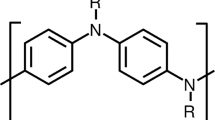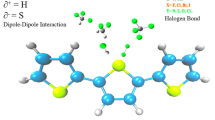Abstract
Conjugated polymers have been considered promising candidates for applications in chemical sensors, mainly due to their high versatility of synthesis, low cost, light weight, and suitable optoelectronic properties. In this context, polythiophene (PT) derivatives have been successfully employed. However, at the same time that the versatility of the synthesis allows the production of varied derivatives, the complexity of interactions with analytes hinders an efficient design of compounds with improved sensing properties. In the present report, electronic structure calculations were employed to identify promising PT derivatives for chemical sensor applications. Structural, optoelectronic, and reactivity properties of a set of branched PT derivatives were evaluated. Adsorption studies considering different gaseous compounds were conducted for selected systems. The results suggest that an appropriate choice of the side groups can lead to derivatives with improved sensorial properties. In particular, PT-CN derivative was identified as the most promising compound for high sensitive chemical sensors towards SO2 and NH3 analytes.











Similar content being viewed by others
References
Liu X, Cheng S, Liu H, Hu S, Zhang D, Ning H (2012). Sensors 12(12):9635–9665. https://doi.org/10.3390/s120709635
Chen Z, Lu C (2005). Sens. Lett. 3(4):274–295. https://doi.org/10.1166/sl.2005.045
Batzill M (2006). Sensors 6(10):1345–1366. https://doi.org/10.3390/s6101345
Yoon H (2013). Nanomaterials 3(3):524–549. https://doi.org/10.3390/nano3030524
Bai H, Shi G (2007). Sensors 7(3):267–307. https://doi.org/10.3390/s7030267
Zeng W, Zhang MQ, Rong MZ, Zheng Q (2007). Sens. Actuators, B 124(1):118–126. https://doi.org/10.1016/j.snb.2006.12.021
Shokuhi-Rad A, Valipour P, Gholizade A, Mousavinezhad SE (2015). Chem Phys Lett 639:29–35. https://doi.org/10.1016/j.cplett.2015.08.062
Shen J, Fujita K, Matsumoto T, Hongo C, Misaki M, Ishida K, Mori A, Nishino T (2017). Macromol Chem Phys 218(19):1700197. https://doi.org/10.1002/macp.201700197
Huang Y, Pappas HC, Zhang L, Wang S, Cai R, Tan W, Wang S, Whitten DG, Schanze KS (2017). Chem Mater 29(15):6389–6395. https://doi.org/10.1021/acs.chemmater.7b01796
Lodola F, Martino N, Tullii G, Lanzani G, Antognazza MR (2017). Sci Rep 7 (1):8477. https://doi.org/10.1038/s41598-017-08541-6
Faisal M, Harraz FA, Al-Salami AE, Al-Sayari SA, Al-Hajry A, Al-Assiri MS (2018). Mat Chem Phys 214:126–134. https://doi.org/10.1016/j.matchemphys.2018.04.085
Xu Z-X, Roy V AL (2014). Chin Phys B 23(4):048501. https://doi.org/10.1088/1674-1056/23/4/048501
Toss H, Suspne C, Piro B, Yassar A, Crispin X, Kergoat L, Pham M-C, Berggren M (2014). Org Electron 15(10):2420–2427. https://doi.org/10.1016/j.orgel.2014.06.017
Fichou D (ed) (1998) Handbook of oligo-? and polythiophenes, 1st edn. Wiley, New York
Pathiranage T M SK, Dissanayake DS, Niermann CN, Ren Y, Biewer MC, Stefan MC (2017). J Polym Sci Part A: Polym Chem 55(20):3327–3346. https://doi.org/10.1002/pola.28726
Granström M, Harrison MG, Friend RH (1998). In: Fichou D (ed) Handbook of oligo- and polythiophenes. 1st edn. Wiley, pp 405–458
Kaloni TP, Giesbrecht PK, Schreckenbach G, Freund MS (2017). Chem Mater 29 (24):10248–10283. https://doi.org/10.1021/acs.chemmater.7b03035
Sajid H, Ayub K, Mahmood T (2019). New J Chem 43(35):14120–14133. https://doi.org/10.1039/C9NJ01894H
ShokuhiRad A, Esfahanian M, Ganjian E, Tayebi H-, Novir SB (2016). J Mol Model 22(6):127. https://doi.org/10.1007/s00894-016-3001-5
Ryan A VM, Taylor CJ (2010) Computational methods for sensor material selection. Springer, Dordrecht
Golsanamlou Z, BagheriTagani M, RahimpourSoleimani H (2018). Phys. E 100:31–39. https://doi.org/10.1016/j.physe.2018.02.024
Dong BX, Nowak C, Onorato JW, Strzalka J, Escobedo FA, Luscombe CK, Nealey PF, Patel SN (2019). Chem Mater 31(4):1418–1429. https://doi.org/10.1021/acs.chemmater.8b05257
Carey FA, Sundberg RJ (2007) Structural effects on stability and reactivity. In: Advanced organic chemistry, Advanced organic chemistry. Springer, US, pp 253–388
Choi J, Kim S, Park J, Lee S, Seo Y, Park D (2019). Polymers 11(4):662. https://doi.org/10.3390/polym11040662
Lacerda G R BS, Calado CR, Calado H DR (2019). J Solid State Electrochem 23 (3):823–835. https://doi.org/10.1007/s10008-018-04185-2
Minkler MJ, Kim J, Lawson KE, Ali A, Zhao R, Adamczyk AJ, Beckingham BS (2019). Mater Lett 256:126563. https://doi.org/10.1016/j.matlet.2019.126563
Warshawsky R, Vaal J, Hewavitharanage P (2017). Eur J Chem 8(4):321–327. https://doi.org/10.5155/eurjchem.8.4.321-327.1634
Zhang B, Yu Y, Zhou J, Wang Z, Tang H, Xie S, Xie Z, Hu L, Yip HL, Ye L, Ade H, Liu Z, He Z, Duan C, Huang F, Cao Y (2020). Adv Energy Mater 10(12):1904247. https://doi.org/10.1002/aenm.201904247
deAraújoNeto LN, doCarmo Alvesde Lima M, deOliveira JF, deSouza ER, Buonafina M DS, VitorAnjos MN, Brayner FA, Alves LC, Neves RP, Mendonca-Junior F JB (2017). Chem-Biol Interact 272:172–181. https://doi.org/10.1016/j.cbi.2017.05.005
Hussein MA (2018). J Polym Environ 26 (3):1194–1205. https://doi.org/10.1007/s10924-017-1023-4
Cui H, Yang X, Peng J, Qiu F (2017). Soft Matter 13(31):5261–5268. https://doi.org/10.1039/C7SM01126A
Jeong I, Jo JW, Bae S, Son HJ, Ko MJ (2019). Dyes Pigm 164:1–6. https://doi.org/10.1016/j.dyepig.2019.01.002
Malkeshi H, MilaniMoghaddam H (2016). J Polym Res 23(6):108. https://doi.org/10.1007/s10965-016-0999-0
Dutta K, Rana D (2019). Eur Polym J 116:370–385. https://doi.org/10.1016/j.eurpolymj.2019.04.033
Stewart J JP (1990). J Comput-Aided Mol Des 4(1):1–103. https://doi.org/10.1007/BF00128336
Oliveira EF, Lavarda FC (2013). J Polym Sci Part B: Polym Phys 51(18):1350–1354. https://doi.org/10.1002/polb.23338
Niaz S, Gülseren O, Khan MA, Ullah I (2018). Eur Phys J Plus 133(11):448. https://doi.org/10.1140/epjp/i2018-12279-3
Nguyen HT, Truong TN (2010). Chem Phys Lett 499 (4-6):263–267. https://doi.org/10.1016/j.cplett.2010.09.049
Tripathy SK, Kitchen D, Druy MA (1983). Macromolecules 16(2):190–192. https://doi.org/10.1021/ma00236a007
Yang S, Li L, Cholli AL, Kumar J, Tripathy SK (2003). Biomacromolecules 4 (2):366–371. https://doi.org/10.1021/bm025687p
Runge E, Gross E KU (1984). Phys Rev Lett 52(12):997–1000. https://doi.org/10.1103/PhysRevLett.52.997
Marques M, Maitra NT, Nogueira F MS, Gross E KU, Rubio A (eds) (2012) Fundamentals of time-dependent density functional theory, Lecture notes in physics. Springer, Heidelberg
Stephens PJ, Devlin FJ, Chabalowski CF, Frisch MJ (1994). J Phys Chem 98 (45):11623–11627. https://doi.org/10.1021/j100096a001
Becke AD (1993). J Chem Phys 98(7):5648–5652. https://doi.org/10.1063/1.464913
Becke AD (1993). J Chem Phys 98(2):1372–1377. https://doi.org/10.1063/1.464304
Buevich AV, Saurí J, Parella T, DeTommasi N, Bifulco G, Williamson RT, Martin GE (2019). Chem Commun 55(41):5781–5784. https://doi.org/10.1039/C9CC02469G
Zhao Y, Truhlar DG (2006). J Phys Chem A 110 (49):13126–13130. https://doi.org/10.1021/jp066479k
Körzdörfer T, Sears JS, Sutton C, Brëdas J-L (2011). J Chem Phys 135(20):204107. https://doi.org/10.1063/1.3663856
Wykes M, Milián-Medina B, Gierschner J (2013) Front Chem 1. https://doi.org/10.3389/fchem.2013.00035
Oliveira EF, Roldao JC, Milián-Medina B, Lavarda FC, Gierschner J (2016). Chem Phys Lett 645:169–173. https://doi.org/10.1016/j.cplett.2015.12.059
Oliveira EF, Lavarda FC (2017). Mol Simul 43(18):1496–1501. https://doi.org/10.1080/08927022.2017.1321759
Meier H, Stalmach U, Kolshorn H (1997). Acta Polym 48(9):379–384. https://doi.org/10.1002/actp.1997.010480905
Batagin-Neto A, Oliveira EF, Graeff CFO, Lavarda FC (2013). Mol Simul 39(4):309–321. https://doi.org/10.1080/08927022.2012.724174
Gierschner J, Cornil J, Egelhaaf H-J (2007). Adv Mater 19 (2):173–191. https://doi.org/10.1002/adma.200600277
Yang W, Mortier WJ (1986). J Am Chem Soc 108 (19):5708–5711. https://doi.org/10.1021/ja00279a008
Lascane LG, Oliveira EF, Batagin-Neto A (2020). MRS Adv 5(10):497–503. https://doi.org/10.1557/adv.2020.203
Mandú LO, Batagin-Neto A (2018). J Mol Model 24(7):157. https://doi.org/10.1007/s00894-018-3660-5
Lascane, LG, Oliveira, EF, Galvão, DS, Batagin-Neto, A (2020) Eur Polym J:110085. https://doi.org/10.1016/j.eurpolymj.2020.110085
DeProft F, VanAlsenoy C, Peeters A, Langenaeker W, Geerlings P (2002). J Comput Chem 23(12):1198–1209. https://doi.org/10.1002/jcc.10067
Frisch MJ, Trucks GW, Schlegel HB, Scuseria GE, Robb MA, Cheeseman JR, Scalmani G, Barone V, Petersson GA, Nakatsuji H, Li X, Caricato M, Marenich AV, Bloino J, Janesko BG, Gomperts R, Mennucci B, Hratchian HP, Ortiz JV, Izmaylov AF, Sonnenberg JL, Williams-Young D, Ding F, Lipparini F, Egidi F, Goings J, Peng B, Petrone A, Henderson T, Ranasinghe D, Zakrzewski VG, Gao J, Rega N, Zheng G, Liang W, Hada M, Ehara M, Toyota K, Fukuda R, Hasegawa J, Ishida M, Nakajima T, Honda Y, Kitao O, Nakai H, Vreven T, Throssell K, Montgomery JA, Peralta JE, Ogliaro F, Bearpark MJ, Heyd JJ, Brothers EN, Kudin KN, Staroverov VN, Keith TA, Kobayashi R, Normand J, Raghavachari K, Rendell AP, Burant JC, Iyengar SS, Tomasi J, Cossi M, Millam JM, Klene M, Adamo C, Cammi R, Ochterski JW, Martin RL, Morokuma K, Farkas O, Foresman JB, Fox DJ (2016) Gaussian 16 Revision B.01. http://gaussian.com/
Gans JD, Shalloway D (2001). J Mol Graphics Modell 19(6):557–559, 609. https://doi.org/10.1016/S1093-3263(01)00090-0
Cummins PL, Titmuss SJ, Jayatilaka D, Bliznyuk AA, Rendell AP, Gready JE (2002). Chem Phys Lett 352(3-4):245–251. https://doi.org/10.1016/S0009-2614(01)01417-8
Boys SF, Bernardi F (1970). Mol Phys 19(4):553–566. https://doi.org/10.1080/00268977000101561
Allouche A-R (2011). J Comput Chem 32(1):174–182. https://doi.org/10.1002/jcc.21600
Bundgaard E, Krebs FC (2007). Sol Energy Mater Sol Cells 91 (11):954–985. https://doi.org/10.1016/j.solmat.2007.01.015
Zhang L, Colella NS, Cherniawski BP, Mannsfeld S CB, Briseno AL (2014). ACS Appl Mater Interfaces 6(8):5327–5343. https://doi.org/10.1021/am4060468
Tokuda T, Hoshino K (2016). Polymer J 48(12):1141–1149. https://doi.org/10.1038/pj.2016.86
Alhalasah W, Holze R (2007). J Solid State Electrochem 11(12):1605–1612. https://doi.org/10.1007/s10008-006-0244-6
Fréchette M, Belletete M, Bergeron J-Y, Durocher G, Leclerc M (1997). Synth Met 84(1-3):223–224. https://doi.org/10.1016/S0379-6779(97)80723-0
Takimiya K, Osaka I, Nakano M (2014). Chem Mater 26(1):587–593. https://doi.org/10.1021/cm4021063
Rahimi K, Botiz I, Agumba JO, Motamen S, Stingelin N, Reiter G (2014). RSC Adv 4(22):11121–11123. https://doi.org/10.1039/C3RA47064D
Savan EbruKUYUMCU, Erdogdu G (2017). J Solid State Electrochem 21(8):2209–2217. https://doi.org/10.1007/s10008-017-3549-8
Öztürk S, Kösemen A, Sen Z, Kilinc N, Harbeck M (2016). Sensors 16(4):423. https://doi.org/10.3390/s16040423
Hamidi-Sakr A, Schiefer D, Covindarassou S, Biniek L, Sommer M, Brinkmann M (2016). Macromolecules 49(9):3452–3462. https://doi.org/10.1021/acs.macromol.6b00495
Baskan H, Unsal C, Karakas H, Sarac AS (2017). Bull Mater Sci 40(5):957–969. https://doi.org/10.1007/s12034-017-1438-5
Wang H, Huang J, Uddin MA, Liu B, Chen P, Shi S, Tang Y, Xing G, Zhang S, Woo HY, Guo H, Guo X (2019). ACS Appl Mater Interfaces 11(10):10089–10098. https://doi.org/10.1021/acsami.8b22457
Radi S, Tighadouini S, Baquet M, Zaghrioui M (2016). J Sulfur Chem 37(3):296–306. https://doi.org/10.1080/17415993.2015.1137920
Bondarev D, Sivkova R, Suly P, Polásková M, Krejcí O, Krikavová R, Trávnícek Z, Zukal A, Kubu M, Sedlácek J (2017). Eur Polym J 92:213–219. https://doi.org/10.1016/j.eurpolymj.2017.04.042
Coleone AP, Lascane LG, Batagin-Neto A (2019). Phys Chem Chem Phys 21(32):17729–17739. https://doi.org/10.1039/C9CP02638J
Petit C, Kante K, Bandosz TJ (2010). Carbon 48 (3):654–667. https://doi.org/10.1016/j.carbon.2009.10.007
Sun S-S, Sariciftci NS (eds) (2005) Organic photovoltaics: mechanisms, materials, and devices, Optical engineering. Taylor & Francis, Boca Raton
Abdou M SA, Orfino FP, Son Y, Holdcroft S (1997). J Am Chem Soc 119(19):4518–4524. https://doi.org/10.1021/ja964229j
Funding
This research was supported by the the Brazilian National Council for Scientific and Technological Development (CNPq) (grant numbers 448310/2014-7, 420449/2018-3 and BHB scholarship - PIBIC) and São Paulo Research Foundation (FAPESP) (grant number 2019/09431-0). This research was also supported by resources supplied by the Center for Scientific Computing (NCC/Grid-UNESP) of the São Paulo State University (UNESP).
Author information
Authors and Affiliations
Corresponding author
Ethics declarations
Conflict of interest
The authors declare that they have no conflicts of interest.
Additional information
Author contributions
All the authors contributed to the conceptualization, formal analyses, investigation, writing—original draft, and writing—review and editing the manuscript. A Batagin-Neto was also responsible for funding acquisition, resources, and supervision.
Data availability
The datasets generated during and/or analyzed during the current study are available from the corresponding author on reasonable request.
Ethical approval
Not applicable.
Consent to participate
Not applicable.
Consent for publication
Not applicable.
Publisher’s note
Springer Nature remains neutral with regard to jurisdictional claims in published maps and institutional affiliations.
Electronic supplementary material
Below is the link to the electronic supplementary material.
Rights and permissions
About this article
Cite this article
Barboza, B.H., Gomes, O.P. & Batagin-Neto, A. Polythiophene derivatives as chemical sensors: a DFT study on the influence of side groups. J Mol Model 27, 17 (2021). https://doi.org/10.1007/s00894-020-04632-w
Received:
Accepted:
Published:
DOI: https://doi.org/10.1007/s00894-020-04632-w




